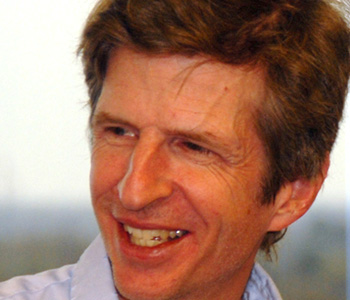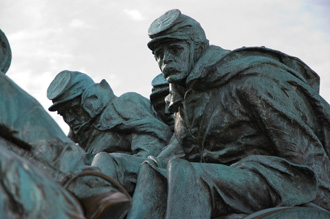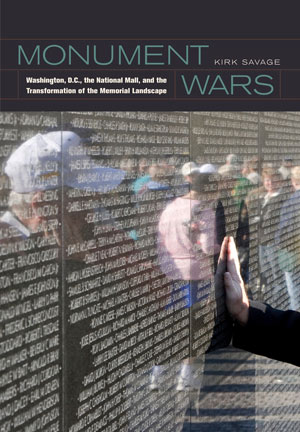
The monumental core of Washington, D.C. is a great axis of public space, almost two miles long, stretching from the Grant Memorial below the U.S. Capitol building to the Lincoln Memorial overlooking the Potomac River. With the mammoth obelisk of the Washington Monument in the center, anchoring its formal geometry, the National Mall looks like it has been there forever. It has become almost a work of nature: in the words of Paul Goldberger, “as essential a part of the American landscape as the Grand Canyon.”
Few visitors to the U.S. capital realize how recent, fragile, and contested this achievement actually is. The monumental core of America is a modern invention of the mid-twentieth century. Realized amid ecological destruction and public controversy, the National Mall is part of a larger transformation of the memorial landscape of Washington and of the nation. Monument Wars tells the story of this sea change in national representation.
Public monuments emerged in the nineteenth century in a loosely connected system of “public grounds”—a decentralized landscape of heroic statues spread out in traffic circles and picturesque parks. The twentieth century witnessed the birth of “public space.” In Washington this resulted in a new spatial system that concentrated authority in an intensified center and demanded a novel psychological engagement from the citizen. In the process, the very idea of the monument changed profoundly, from an object of reverence to a space of experience.
The shift from public ground to public space has had unforeseen consequences, introducing tragedy and trauma into the memorial landscape and leaving Americans now with multiple paradoxes of national identity in an era of increasing global insecurity.

“The creation of the Lincoln and Grant memorials, intended to unify the Mall around a Civil War narrative of national rebirth, introduced notes of suffering and tragedy into what had been an exclusively triumphal landscape.”
Washington, D.C. may be the most studied national capital in the world. There are dozens of guidebooks to Washington’s monuments and countless specialized studies of individual projects, landscape plans, and designers. But during my twenty years of research on the city and its monuments, I became convinced that a wider conceptual lens was not only possible, but necessary.
It was plain to see that even over my own professional lifetime, much had changed. The increasing prominence of war memorials on the west end of the Mall and a new attention to historical trauma brought on by the nation’s increasingly fraught engagement with the rest of the world were reshaping the monumental core. In order to understand these changes it became necessary to go back to their origins and examine how and why the landscape had changed so fundamentally.
The basic monumental framework of the capital was laid out by a French artist, military engineer, and polymath, Pierre L’Enfant, working under George Washington at the end of the eighteenth century. His plan, steeped in the language of military conquest and occupation, established symbolic possession of the city and the continent with a grandiose scheme of multiple centers and public monuments spread across the far-flung grid of the city. Almost none of his specific ideas came to fruition, but the general idea of a dispersed monumental landscape did take hold in the multiple public grounds that emerged in the second half of the nineteenth century.
A parade of individual heroes, typically military commanders, standing or riding on high pedestals, spread out across the developing city, dotting its many tree-lined squares and circles left over from L’Enfant’s street layout. Often renaming the grounds they decorated, these heroic statues began to create a kind of cognitive map of the city and the nation. Even at the center, the Mall became a polyglot arrangement of grounds: gardens, greenhouses, woods, and the occasional statue (though to relatively minor figures, like a surgeon and a scientist). But just as the capital was becoming world famous for its statues and its trees, this landscape fell victim to modern systems of spatial thinking and design.
I first noticed years ago that the term “public space” hardly ever appeared in the nineteenth century, while “public grounds” were ubiquitous. With the advent of full-text search engines, I was able to demonstrate more convincingly that the change from ground to space was not just a linguistic shift, but a conceptual and psychological one as well. Space, which had been thought of as mere emptiness in the nineteenth century, acquired a positive agency in the twentieth.
Conceptually, space became a force to impose order and to control perception and experience. Consider the clearing of the national Mall, a massive project involving the devaluation and destruction of acres of carefully nurtured grounds. Thousands of trees and hundreds of homes were sacrificed to make room for an axis of space lined with miles of new roads.
This project is often misunderstood as a reactionary return to the classicism of L’Enfant and Baroque garden designers, when it should be seen instead as an early example of modern urban renewal. The transformation of the monumental core from local grounds to national space, against decades of opposition from Washington residents, revealed the nation as a mysterious organizing force, rivaling nature itself.
At the same time the devaluation of the old memorial landscape in favor of a highly charged central space had some unintended consequences. The creation of the Lincoln and Grant memorials, intended to unify the Mall around a Civil War narrative of national rebirth, introduced notes of suffering and tragedy into what had been an exclusively triumphal landscape. Grant and Lincoln emerged as complex figures, both heroes and victims of history’s vicissitudes. The monuments themselves turned from objects on pedestals to integrated spatial designs. Physical space thus became psychological space, engaging its viewers in a new experience of historical complexity and trauma.
Ultimately the entire Mall turned into a space of national conscience, as its large open areas and architectural platforms became the premier public stage for democratic protest. These developments eventually gave rise to the modern victim monument, brilliantly implemented in Maya Lin’s Vietnam Veterans Memorial, and to counter-reactions such as the World War II Memorial, which nostalgically reasserts the old triumphalism of the nineteenth century.
The completion in 1884 of the Washington Monument—the great obelisk in the center of the Mall—is the pivotal moment in the book’s larger narrative. While the project began in the early nineteenth century, it wasn’t until a brilliant West Point officer named Thomas Lincoln Casey, from the Army Corps of Engineers, took hold of it in the late 1870s that the monument would finally be finished.
Casey became obsessed with the ancient purity of the obelisk form and the technical challenge of how to inflate the form into a modern electrified skyscraper. Initially dismissing the whole project as the “football of quacks,” Casey soon imposed his own personal vision on it, despite the united opposition of Congress and the art world to the obelisk scheme. He transformed the early-nineteenth century idea of a Revolutionary pantheon into a plain, crystalline shaft equipped with an elevator and observation windows at the top— a technological marvel in rigorously abstract form. How he managed this feat is a tale of engineering and bureaucratic wizardry. For a short while the Washington Monument became the tallest structure in the world. The great shaft introduced a new spatial experience into the Mall landscape and signaled the beginning of the end of the old scheme of public grounds.
In many respects the story is typical of the aesthetic and political controversies that have plagued the memorial landscape from the founding of the nation. Americans have long had a love-hate relationship with the public monument. In the earliest debates Congress had on the subject of a memorial to George Washington, many argued that Washington needed no monument and that monuments were “good for nothing” in a democratic society. The question of the appropriate form was at once a political question, as partisan as any legislative issue then or now.
But due to the scale of the project, and the rigor of Casey’s approach, the Washington Monument became a unique achievement, a game-changing accomplishment. In its final form it had absolutely nothing to do with the wooded grounds and gardens that surrounded it and was a strange departure from the heroic statues that populated the city’s streets and parks.
Visitors who took the elevator to the top found themselves in a new abstract spatial realm, so far removed from the ground that the ordinary benchmarks of human existence no longer seemed to apply. On the ground many continued to wrestle with the monument’s mystifying blankness; they imagined that the monument would one day be “finished” with appropriate inscriptions or narrative scenes. But the real completion of the monument would come when the landscape around it was cleared and transformed, creating a new, more abstract space that would remold the nation’s center in the monument’s image. Without Casey’s magnificent obelisk, the nation’s monumental core might never have emerged.
“Without a brilliant West Point officer named Thomas Lincoln Casey, the nation’s monumental core might never have emerged.”
At the end of the book I discuss the paradox of the public monument: meant to be permanent and “timeless,” monuments typically slide into obsolescence.
Even as brilliant a monument as Maya Lin’s Vietnam Veterans Memorial has lost some of its original charge as the veterans of that era grow old and the events retreat into ever more distant memory. For this reason the sponsors are now planning a huge underground visitors’ center near Lin’s wall, which will supplement her memorial with museum displays about the war and pictures of the men whose names appear on the wall. But this solution simply raises new questions. Does every war memorial deserve an accompanying museum? And who deserves a monument in the first place? If the twentieth century witnessed a shift from the great hero to the ordinary soldier and even to history’s victims, then which victims merit a name on a wall or a picture in a museum?
Meanwhile the great space of the Mall has already changed radically since its birth in the mid-twentieth century. The Civil War theme of its original design has been overshadowed by a series of major monuments to America’s wars in Europe and Asia. Since the attacks of September 11, the space itself has been carved up by security walls and by the immense new barrier of the World War II Memorial. Yet despite all these changes the monuments that get built continue to be the products of special interest groups that can successfully navigate a byzantine legislative and regulatory process. Change occurs, but in a haphazard, ad hoc way.
To expand the possibilities for democratic debate and representation, the closing pages of Monument Wars propose a moratorium on permanent public monuments in the capital, and a period of experimentation in which many groups and designers would be empowered to erect temporary memorials and installations.
While it is doubtful that this simple proposal will find much support in the current political climate, I am gratified that the book is being read and discussed within the planning bodies that do have responsibility for stewarding the Mall and its monuments. If Monument Wars can make even a modest contribution to a more open and informed national conversation about the landscape of public memory, then it will have done its job.


Kirk Savage is professor of the history of art and architecture at the University of Pittsburgh. He has been writing on public monuments for over twenty-five years. His first book, Standing Soldiers, Kneeling Slaves: Race, War, and Monument in Nineteenth-Century America, won the 1998 John Hope Franklin Publication Prize as best book in American Studies. In addition to academic publishing, he contributes opinion pieces and book reviews to the Washington Post.